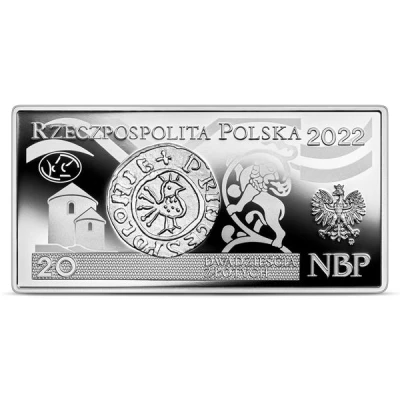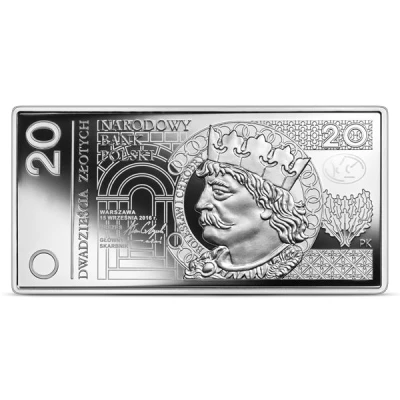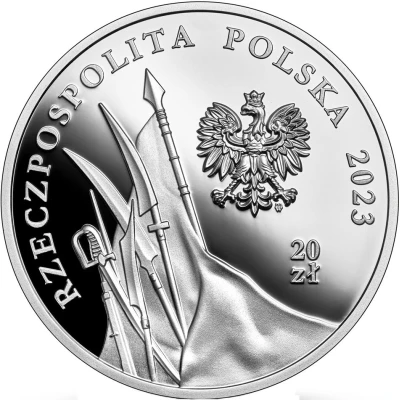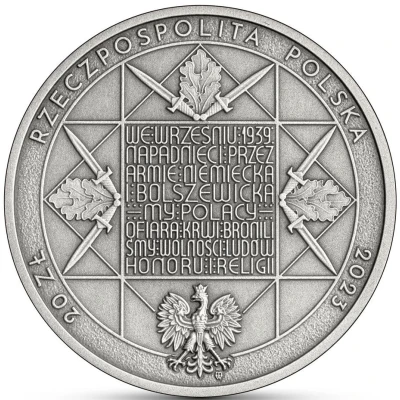
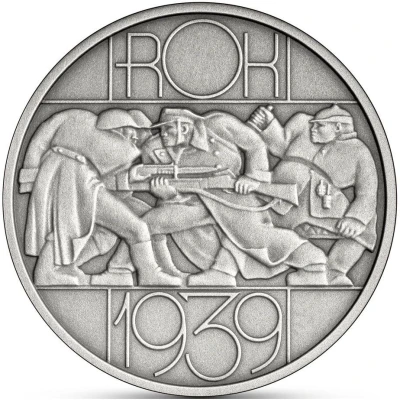

© Narodowy Bank Polski
20 Zlotys Soviet Aggression against Poland – 17 September
2023 year| Silver (.925) | 28.28 g | 38.61 mm |
| Issuer | Poland |
|---|---|
| Period | Third Republic (1989-date) |
| Type | Non-circulating coin |
| Year | 2023 |
| Value | 20 Zlotys (20 Złotych) 20 PLN = USD 5.08 |
| Currency | Fourth Zloty (1995-date) |
| Composition | Silver (.925) |
| Weight | 28.28 g |
| Diameter | 38.61 mm |
| Shape | Round |
| Technique | Milled |
| Updated | 2024-10-07 |
| Numista | N#377305 |
|---|---|
| Rarity index | 93% |
Reverse
The “Year 1939” medal, which is the source of images for the coin design, was authored by a renowned sculptor Józef Gosławski (1908–1963). The scene on the obverse is a symbolic representation of the events of 17 September 1939 – a Polish soldier fighting the German aggressor is stabbed in the back by a Red Army soldier.
Comment
In its plan of war against Germany, the Command of the Polish Armed Forces assumed the neutrality of the USSR, thus only token forces were left near the Polish-Soviet border. Therefore, the unprovoked Soviet aggression did not meet organized resistance. Nevertheless, the troops of the Border Protection Corps (BPC) took up the fight. The heroic resistance of the few border outposts delayed the actions of the aggressor.The defence of Grodno went down in the annals of Polish military history, as did cavalry engagements near Skidel and Kodziowce, where the positions were gallantly defended by the 101st Uhlan Regiment under Major Stanisław Żukowski. For two weeks the Commander of the Border Protection Corps, General Wilhelm Orlik-Rückemann, led the BPC battle group in hard-fought battles and skirmishes against the Soviets near Sarny, at Ratno, Szack and Wytyczne. In turn, the 3rd Infantry Regiment of the BPC under Colonel Zdzisław Zajączkowski went into battle at Borowicze, Nawóz and Janówka in the Polesie region. The Nowogródek Cavalry Brigade fought near Wola Sudkowska and Władypole. Also troops commanded by General Franciszek Kleeberg won victories at Jabłoń and Milanów.
In north-eastern regions, General Józef Olszyna-Wilczyński tried to mount organized resistance against the Red Army. The situation was exacerbated by sabotage groups formed by national minorities, which attacked units of the Polish Army and killed isolated soldiers or small groups of soldiers as well as members of state administration and their families.
The defence of the Polish state against this incursion involved not only the Polish army but also civilians, in particular scouts and students. Their participation was a testimony to the imperative of defence of the Polish character of Eastern Borderlands.
The Soviet aggression was a mortal blow to the Polish Army already engaged in a bloody struggle against the Germans. It ruled out the possibility of continued resistance on the so-called Romanian bridgehead. On 17 September at 10 pm, following several hours of hostilities on the Polish--Soviet border, the Polish commander-in-chief, Marshal Edward Rydz-Śmigły issued a directive opening with the
words: “The Soviets have entered. I order a general withdrawal to Romania and Hungary by the shortest routes. Do not fight the Bolsheviks, except in case of an attack from their side or an attempt to disarm the troops.” The decision was motivated by the intention to prevent fighting with no hope of victory. The main goal was to preserve own forces in order to continue the war at the side of the French and British allies.
The repression of the Polish nation which started with the Soviet aggression on 17 September 1939 continued until 1989.
Prof. Wiesław Wysocki
Interesting fact
The coin commemorates the 84th anniversary of the Soviet aggression against Poland, which took place on September 17, 1939. The coin's design features a symbolic image of a Polish soldier standing against a background of a torn flag, representing the country's struggle for independence and freedom. The coin's obverse side features an image of the Polish coat of arms, while the reverse side features an inscription in Polish that translates to "Soviet Aggression against Poland - 17 September 1939."
Price
| Date | Mintage | VG | F | VF | XF | AU | UNC |
|---|---|---|---|---|---|---|---|
| 2023 MW | 12000 | - | - | - | - | - | - |
Values in the table are based on evaluations by sales realized on Internet platforms. They serve as an indication only for 20 Zlotys (Soviet Aggression against Poland – 17 September 1939) 2023 coin.
